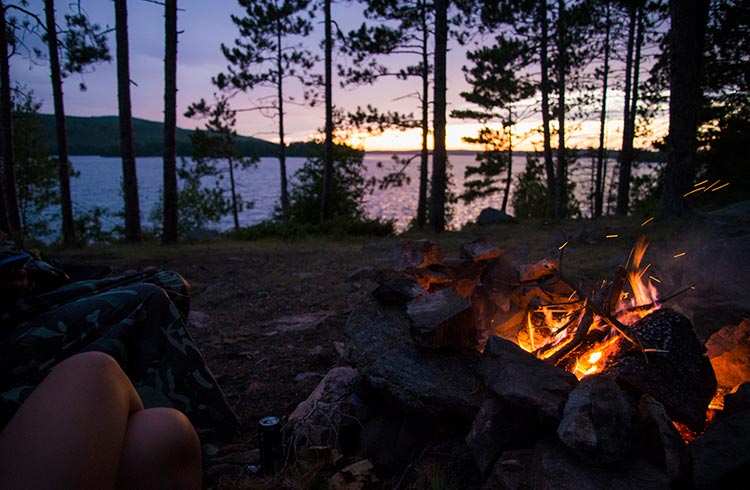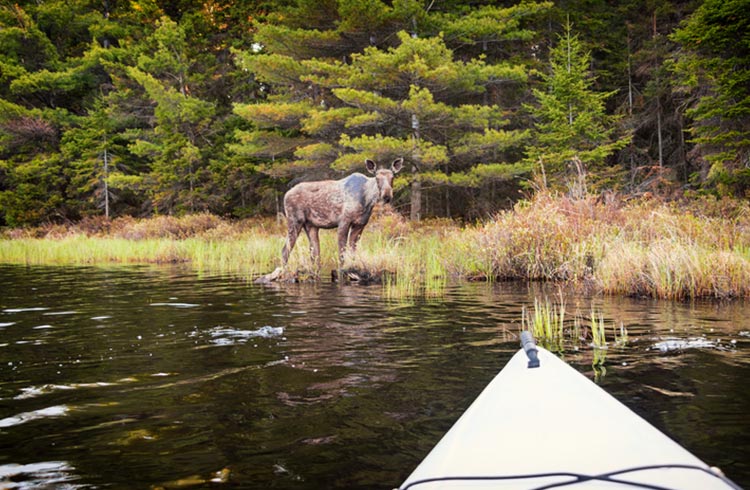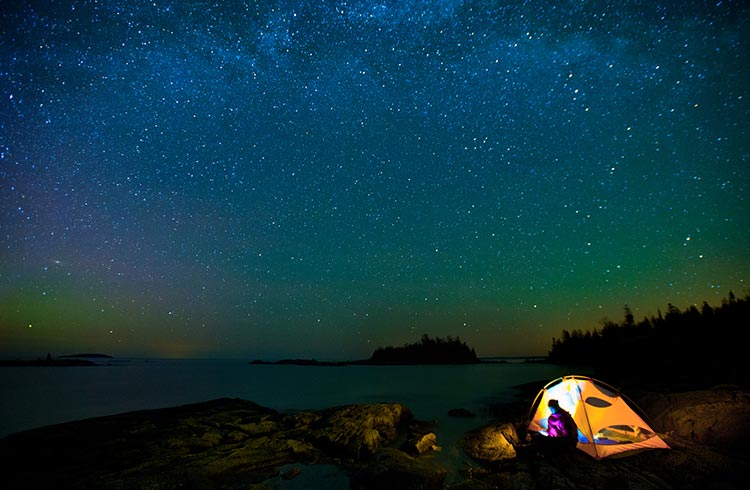5 Essential Tips to Survive the Canadian Wilderness
Experiencing Canada's wilderness requires some thorough planning. The more preparation for the wilderness, the far better off you'll be.
Shares
 Photo © iStock/alex_j_walsh
Photo © iStock/alex_j_walsh
- Wilderness Tips for Canada
- Preparing to Tackle Canada's Wild
- Bears in Canada
- Whale Watching Tips
- Insects and Bugs
1. Wilderness tips for Canada
With almost 10 million square kilometers of country to explore and epic landscapes stretching from coast to coast, Canada's wealth of natural beauty and wildlife are an almost irresistible call to nature-lovers and adventurers. The promise of eye-popping views and the chance to snap some of Canada's impressively large wildlife draws thousands of travelers to the Canadian wilderness every year.
Before you strap on a backpack and plunge head-first into the nearest forest, consider the respect Canucks have for their potentially harsh homeland, and absorb some wilderness wisdom.

2. Wilderness safety in Canada
Canada boasts 39 National Parks and eight National Park Reserves, spanning plains and prairies to frozen peaks. While these protected areas are often the best place to experience the Canadian landscape, they make up only 2.5% of the country's immense landmass. The sheer size of Canada means there is almost an unending supply of trails and paths to follow or forge.
It's the perfect place to lose yourself in the wonder of nature. Unfortunately, this means you can quite literally lose yourself. So, here are some tips to make sure you'll be back to spread the word about Canada's beauty.
Preparation is the key to a successful hike, whether you're intending to go for a few hours or several days. Make sure you're carrying adequate clothing and supplies as well as a detailed map of the area.
Only hike to your level of experience and ability. Study your intended route or ask for some local advice to make sure you're not biting off more than you can chew.
Always let someone know what your plans are, where you're heading and when you'll be back – or you could find yourself in the middle of a very large search area.
The more detailed your plan, the better, but always be ready to adapt to changing conditions. Putting your head down and proceeding regardless of the situation can be just as dangerous as never having a plan to start with.
Spring and summer can offer perfect hiking conditions, but snowmelt, changing weather, and freshly built beaver dams can see the trail you're following come to an abrupt (and soggy) end. While this doesn't have to bring an end to your experience, it's not a great idea to detour miles off your route unless you have a local guide or extensive navigating experience.
If you do find yourself temporarily misplaced, your best bet is to stay put. If you really don't know where you are, any direction you take has a high chance of being the wrong one, meaning the further you walk, the longer it will take rescuers to find you.
Instead, sit down and have a drink or something to eat, and take in your surroundings. Unless you suddenly realise you're just meters from the trail, your next priorities should be staying warm, staying hydrated and staying visible for the Mounties.

3. Bear safety in Canada
If you're lucky you'll come across some of Canada's iconic creatures, the bear and the moose. These massive mammals are common throughout the country and if treated with caution and respect, your encounter can make for some fantastic photos.
Despite Canada's high population of bears, attacks are uncommon. Neither of the most common species (black bears and grizzlies) view humans as prey, and will generally go out of their way to avoid people.
Sudden encounters are when a bear's natural avoidance instinct is most likely to shift to aggression. The easiest way to avoid these situations, is to warn the bear of your approach. Make a lot of noise while you're walking, especially if you see signs of bears in the area. They may look calm and approachable but this misconception is what leads to the majority of attacks.
In fact, most incidents involving tourists occur in places where bears come into contact with humans often, mainly in popular camping grounds or sighting hotspots. In these cases bears come to see humans as a source of food and become more adventurous and demanding.
Strange smells or the smell of your food is also enough to attract a bear's attention, so make sure you comply with the national park's food storage rules and don't wear any strong perfumes or cosmetics.
If you're camping, it's wise to change out of the clothes you cooked in before going to sleep. You may not look like a freshly grilled hotdog to a bear, but it's best not to smell like one either.
Canadians have a saying: A fed bear is a dead bear. Animals that come to see humans as a source of food are often classified as "nuisance bears" and will be killed by conservation officials. So if you're careless with your food or reckless around bears, you're not only putting yourself in danger, but the animal itself.
If you're a real animal lover youill admire them from a distance, not kill them with kindness.
Two Vancouver Island men were attacked in their tent and badly injured by a bear while camping near Port Alberni in 2010. However, they admitted they'd seen the bear when they first set up their campsite and it had returned several times over the next five days.
If you see signs of a bear while camping or walking, please don't stick around too long.
Polar bears
Some intrepid adventurers may choose to head out to Churchill, Manitoba in the hope of catching a glimpse of the ghostly and endangered polar bear. There are plenty of polar bear tours designed to get close to these fearsome creatures, but melting ice caps mean you might get more than you bargained for.
If the sea ice doesn't harden over winter, the bears' hunting grounds are greatly diminished, and they have increasingly been forced to venture into towns in search of food – which could be you.
Unlike Canada's other native predators, a polar bear will consider a walking meat stick. Fortunately not one he enjoys very much, but flavour isn't of huge importance to a starving creature.
If you're with a well-trained and equipped tour guide, you should be quite safe. But if you encounter a polar bear unexpectedly remember, don't run. A fleeing animal arouses a bear's hunting instincts. They will chase you and, as bears can run about as fast a horse, they will catch you.
Calmly exit the area or try to get inside. Don't turn your back but try not to make direct eye contact.
It's worthwhile mentioning that the polar bears scientific name is ursus maritimis – sea bear. So swimming to safety is a no-no.
Parks Canada has a detailed safety guide explaining how to react if you come into contact with a bear, which you can read here.
Moose
Canada's other mammoth mammal is slightly less fearsome-looking than the bear, but can be just as deadly.
The moose is generally as harmless as its bizarre body shape would suggest, but males grow up to 800kg and can cause a lot of damage, whether they mean to or not. The majority of moose-related accidents happen on the roads, where the animal's size and body shape mean it's a real danger to drivers.
They are not generally aggressive towards humans, but have been known to charge if frightened or startled. Again, make sure to make a lot of noise while you're walking. Because of their size, moose generally choose to stand their ground when threatened, rather than flee. But just because he's stuck around doesn't mean he wants to be friends. Give this prospective buddy a wide berth.
Because moose are not carnivorous or predatory, they are very unlikely to pursue you, so feel free to make a hasty exit if you do stumble across a cranky specimen.
Is it safe to bring your dog to the park?
Wolves are one of the primary predators for a moose and as a result, they're not overly fond of dogs. Your pooch could provoke an otherwise docile moose into attacking, so keep it on a lead.
4. Whale watching tips
If Canada's massive land mammals aren't quite big enough for your tastes you could always take to the sea for a spot of whale watching. The Atlantic east coast holds a hugely diverse population of whales, from little belugas to the immense blue. Despite this, there are more tour companies on the west coast, where tourists can hope to catch a glimpse of an orca.
Like any wildlife tour, nothing is certain, and it's important to maintain realistic expectations for your outing. You may watch whales socialising with seals and dolphins, you may witness orcas organising a hunt or you may struggle to see a single fish. Most tour companies offer a "sighting guarantee" but these generally just consist of another trip, which is unlikely to fit into your holiday schedule.
Weather and sea conditions also affect the tours' operation, so call the company to ensure tours are running if you want to save yourself a pointless trip out.

5. Insects and bugs
Despite the awesome size of some of Canada's creatures, you also need to be wary of some smaller residents. While these little suckers are always annoying, the risk of disease means they could end up having a big impact on your holiday.
Mosquitoes in Canada are known to carry West Nile Fever which, while almost always harmless, can take a nasty turn. In 2017, there have been over 130 clinical cases of West Nile virus, however the vast majority of those who are infected experience no ill effects whatsoever.
There is no vaccination for West Nile Fever but fortunately, only 10 of Canada's 74 species of mosquito are known to carry the virus, so the risk of being infected is very low. Most human infections happen during July and August, but whatever season you visit, remember to cover up as much as possible and use plenty of insect repellent, especially at dusk and dawn.
Deer ticks are common in the southern areas of Canada, especially along the US border. Their bites can lead to Lyme disease, which can cause mild flu symptoms in its early stages but can develop into much more serious illness down the track.
Make sure to check yourself for ticks every night while trekking or camping and shake out your clothes to get rid of any persistent pests. If you have been infected, the most noticeable symptom is an expanding, target-shaped red rash. Lyme disease is very treatable so get to a doctor and they can help you out.
Perhaps the most persistent little pest you can expect to encounter is the black fly. Most common around rivers in the east, these little bloodsuckers are unbelievably unrelenting, making Australian flies look like bloated slackers. For the most part, insect repellent will keep them at bay, but it's wise to also cover up as much as possible.
For some reason lighter shades of clothing seem to keep black flies off your back. The evidence is purely anecdotal, so our only explanation is that the pale palette looks slightly less delicious to them.
Simple and flexible travel insurance
You can buy at home or while traveling, and claim online from anywhere in the world. With 150+ adventure activities covered and 24/7 emergency assistance.
Get a quote
No Comments